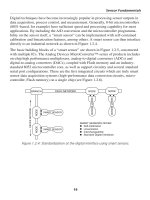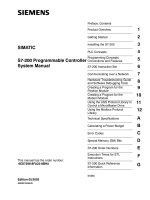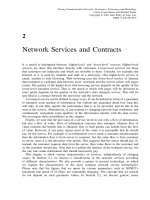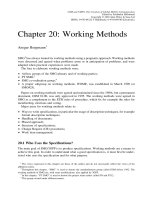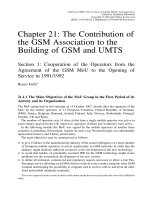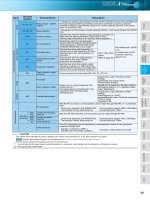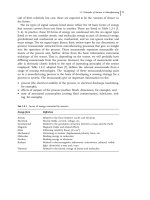Tài liệu Instrumentation and Control P2 ppt
Bạn đang xem bản rút gọn của tài liệu. Xem và tải ngay bản đầy đủ của tài liệu tại đây (540.16 KB, 30 trang )
Preface, Contents
Product Overview
1
Getting Started
2
Installing the S7-200
3
PLC Concepts
4
Programming Concepts,
Conventions and Features
5
S7-200 Instruction Set
6
Communicating over a Network
7
Hardware Troubleshooting Guide
and Software Debugging Tools
8
Creating a Program for the
Position Module
9
Creating a Program for the
Modem Module
10
Using the USS Protocol Library to
Control a MicroMaster Drive
11
Using the Modbus Protocol
Library
12
Technical Specifications
A
Calculating a Power Budget
B
Error Codes
C
Special Memory (SM) Bits
D
S7-200 Order Numbers
E
Execution Times for STL
Instructions
F
S7-200 Quick Reference
Information
G
Index
S7-200 Programmable Controller
System Manual
SIMATIC
Edition 05/2003
A5E00212536-02
This manual has the order number:
6ES7298-8FA23-8BH0
Contents
ii
Safety Guidelines
This manual contains notices which you should observe to ensure your own personal safety, as well as to
protect the product and connected equipment. These notices are highlighted in the manual by a warning
triangle and are marked as follows according to the level of danger:
Danger
Danger indicates an imminently hazardous situation which, if not avoided, will result in death or serious
injury.
Warning
Warning indicates a potentially hazardous situation which, if not avoided, could result in death or serious
injury.
Caution
Caution used with the safety alert symbol indicates a potentially hazardous situation which, if not
avoided, may result in minor or moderate injury.
Caution
Caution used without the safety alert symbol indicates a potentially hazardous situation which, if not
avoided, may result in property damage.
Notice
Notice indicates a potential situation which, if not avoided, may result in an undesirable result or state.
Qualified Personnel
Only qualified personnel should be allowed to install and work on this equipment. Qualified persons are
defined as persons who are authorized to commission, to ground, and to tag circuits, equipment, and sys-
tems in accordance with established safety practices and standards.
Correct Usage
Note the following:
Warning
This device and its components may only be used for the applications described in the catalog or the
technical descriptions, and only in connection with devices or components from other manufacturers
which have been approved or recommended by Siemens.
This product can only function correctly and safely if it is transported, stored, set up, and installed
correctly, and operated and maintained as recommended.
Trademarks
SIMATICR, SIMATIC HMIR and SIMATIC NETR are registered trademarks of SIEMENS AG.
Some of other designations used in these documents are also registered trademarks; the owner’s rights may be violated
if they are used by third parties for their own purposes.
We have checked the contents of this manual for agreement with the hardware and
software described. Since deviations cannot be precluded entirely, we cannot gua-
rantee full agreement. However, the data in this manual are reviewed regularly and
any necessary corrections included in subsequent editions. Suggestions for impro-
vement are welcomed.
Disclaimer of LiabilityCopyright Siemens AG 2003 All rights reserved
The reproduction, transmission or use of this document or its contents is not
permitted without express written authority. Offenders will be liable for damages.
All rights, including rights created by patent grant or registration of a utility model
or design, are reserved.
Siemens AG
Bereich Automation and Drives
Geschaeftsgebiet Industrial Automation Systems
Postfach 4848, D- 90327 Nuernberg
E Siemens AG 2003
Technical data subject to change.
Siemens Aktiengesellschaft 6ES7298-8FA23-8BH0
iii
Preface
The S7-200 series is a line of micro-programmable logic controllers (Micro PLCs) that can control a
variety of automation applications. Compact design, low cost, and a powerful instruction set make the
S7-200 a perfect solution for controlling small applications. The wide variety of S7-200 models and the
Windows-based programming tool give you the flexibility you need to solve your automation problems.
Audience
This manual provides information about installing and programming the S7-200 Micro PLCs and is
designed for engineers, programmers, installers, and electricians who have a general knowledge of
programmable logic controllers.
Scope of the Manual
The information contained in this manual pertains in particular to the following products:
-
S7-200 CPU models: CPU 221, CPU 222, CPU 224, CPU 226, and CPU 226XM
-
S7-200 EM 22x expansion modules
-
STEP 7--Micro/WIN, version 3.2, a 32-bit programming software package for the S7-200
-
STEP 7--Micro/WIN Instruction Libraries and TP-Designer for TP070, Version 1.0, a set of
software tools for customers who use an S7-200 with other components, such as the TP070
Touch Panel, Modbus, or a MicroMaster drive
Standards Compliance
The SIMATIC S7-200 series meets the following standards:
-
European Community (CE) Low Voltage Directive 73/23/EEC
EN 61131--2: Programmable Controllers -- Equipment requirements
-
European Community (CE) EMC Directive 89/336/EEC
Electromagnetic emissions standard
EN 61000--6--3: residential, commercial, and light industry
EN 61000--6--4: industrial environment
Electromagnetic immunity standards
EN 61000--6--2: industrial environment
-
Underwriters Laboratories, Inc.
UL 508 Listed (Industrial Control Equipment) Registration number E75310
-
Canadian Standards Association: CSA C22.2 Number 142 (Process Control Equipment)
-
Factory Mutual Research: FM Class I, Division 2, Groups A, B, C, & D Hazardous Locations, T4A
and Class I, Zone 2, IIC, T4
Refer to Appendix A for compliance information.
Tip
The SIMATIC S7-200 series meets the CSA standard.
The cULus logo indicates that the S7-200 has been examined and certified by Underwriters
Laboratories (UL) to standards UL 508 and CSA 22.2 No. 142.
Contents
iv
Maritime Approvals
The S7-200 products are periodically submitted for special agency approvals related to specific markets
and applications. This table identifies the agency and certificate number that the S7-200 products have
been approved for. Not all S7-200 products in this manual have been approved for these special agency
approvals. Consult your local Siemens representative if you need additional information related to the
latest listing of exact approvals by part number.
Agency Certificate Number
Lloyds Register of Shipping (LRS) 99 / 20018(E1)
American Bureau of Shipping (ABS) 01--HG20020--PDA
Germanischer Lloyd (GL) 12 045 -- 98 HH
Det Norske Veritas (DNV) A--8071
Bureau Veritas (BV) 09051 / A2 BV
Nippon Kaiji Kyokai (NK) A--534
How to Use This Manual
If you are a first-time (novice) user of S7-200 Micro PLCs, you should read the entire S7-200
Programmable Controller System Manual. If you are an experienced user, refer to the table of contents
or index to find specific information.
The S7-200 Programmable Controller System Manual is organized according to the following topics:
-
Chapter 1 (Product Overview) provides an overview of some of the features of the S7-200 family
of Micro PLC products.
-
Chapter 2 (Getting Started) provides a tutorial for creating and downloading a sample control
program to an S7-200.
-
Chapter 3 (Installing the S7-200) provides the dimensions and basic guidelines for installing the
S7-200 CPU modules and expansion I/O modules.
-
Chapter 4 (PLC Concepts) provides information about the operation of the S7-200.
-
Chapter 5 (Programming Concepts, Conventions, and Features) provides information about the
features of STEP 7--Micro/WIN, the program editors and types of instructions (IEC 1131-3 or
SIMATIC), S7-200 data types, and guidelines for creating programs.
-
Chapter 6 (S7-200 Instruction Set) provides descriptions and examples of programming
instructions supported by the S7-200.
-
Chapter 7 (Communicating over a Network) provides information for setting up the different
network configurations supported by the S7-200.
-
Chapter 8 (Hardware Troubleshooting Guide and Software Debugging Tools) provides information
for troubleshooting problems with the S7-200 hardware and about the STEP 7--Micro/WIN
features that help you debug your program.
-
Chapter 9 (Creating a Program for the Position Module) provides information about the
instructions and wizard used to create a program for the EM 253 Position module.
-
Chapter 10 (Creating a Program for the Modem Module) provides information about the
instructions and wizard used to create a program for the EM 241 Modem module.
-
Chapter 11 (Using the USS Protocol Library to Control a MicroMaster Drive) provides information
about the instructions used to create a control program for a MicroMaster drive. It also provides
information about how to configure the MicroMaster 3 and MicroMaster 4 drives.
-
Chapter 12 (Using the Modbus Protocol Library) provides information about the instructions used
to create a program that uses the Modbus protocol for communications.
-
Appendix A (Technical Specifications) provides the technical information and data sheets about
the S7-200 hardware.
The other appendices provide additional reference information, such as descriptions of the error codes,
descriptions of the Special Memory (SM) area, part numbers for ordering S7-200 equipment, and STL
instruction execution times.
Preface
v
Additional Information and Assistance
Information about the S7-200 and STEP 7--Micro/WIN
In addition to this manual, STEP 7--Micro/WIN provides extensive online help for getting started with
programming the S7-200. Included with the purchase of the STEP 7--Micro/WIN software is a free
documentation CD. On this CD you can find application tips, an electronic version of this manual and
other information.
Online Help
Help is only a keystroke away! Pressing F1 accesses the extensive online help for STEP 7--Micro/WIN.
The online help includes useful information about getting started with programming the S7-200, as well
as many other topics.
Electronic Manual
An electronic version of this S7-200 System Manual is available on the documentation CD. You can
install the electronic manual onto your computer so that you can easily access the information in the
manual while you are working with the STEP 7--Micro/WIN software.
Programming Tips
The documentation CD includes Programming Tips, a set of application examples with sample
programs. Reviewing or modifying these examples can help you find efficient or innovative solutions for
your own application. You can also find the most current version of Programming Tips on the S7-200
Internet site.
Internet: www.siemens.com/S7--200
For additional information about Siemens products and services, technical support, frequently asked
questions (FAQs), product updates, or application tips, refer to the following Internet addresses:
-
www.ad.siemens.de for general Siemens information
This Siemens Automation & Drives Internet site includes information about the SIMATIC product
line and other products available from Siemens.
-
www.siemens.com/S7--200 for S7-200 product information
The S7-200 Internet site includes frequently asked questions (FAQs), Programming Tips
(application examples and sample programs), information about newly released products, and
product updates or downloads.
Contents
vi
Technical Assistance and Purchasing S7-200 Products
Local Siemens Sales Office or Distributor
For assistance in answering any technical questions, for training on the S7-200 products, or for ordering
S7-200 products, contact your Siemens distributor or sales office. Because your sales representatives
are technically trained and have the most specific knowledge about your operations, process and
industry, as well as about the individual Siemens products that you are using, they can provide the
fastest and most efficient answers to any problems that you might encounter.
Technical Services
The highly trained staff of the S7-200 Technical Services center is also available to help you solve any
problems that you might encounter. You can call on them 24 hours a day, 7 days a week:
-
For calls originating from within the United States of America
Local time: Monday to Friday 0800 to 1900 Eastern time
Telephone: +1 800 241--4453
Fax: +1 (0) 770 740--3699
E-Mail:
-
For calls originating from the Americas outside of the USA
Local time: Monday to Friday 0800 to 1900 Eastern time
Telephone: +1 (0) 770 740--3505
Fax: +1 (0) 770 740--3699
E-Mail:
-
For calls originating from Europe and Africa
Local time (Nuremberg): Monday to Friday 0700 to 1700
Telephone: +49 (0) 180 5050--222
Fax: +49 (0) 180 5050--223
E-Mail:
-
For calls originating from Asia and Australia
Local time (Singapore): Monday to Friday 0830 to 1730
Telephone: +65 (0) 740--7000
Fax: +65 (0) 740--7001
E-Mail:
vii
Contents
1 Product Overview 1.............................................................
S7-200 CPU 2..........................................................................
S7-200 Expansion Modules 3.............................................................
STEP 7--Micro/WIN Programming Package 3................................................
Communications Options 4...............................................................
Display Panels 4........................................................................
2 Getting Started 5................................................................
Connecting the S7-200 CPU 6............................................................
Creating a Sample Program 9.............................................................
Downloading the Sample Program 12.......................................................
Placing the S7-200 in RUN Mode 12........................................................
3 Installing the S7-200 13...........................................................
Guidelines for Installing S7-200 Devices 14..................................................
Installing and Removing the S7-200 Modules 15..............................................
Guidelines for Grounding and Wiring 18.....................................................
4 PLC Concepts 21.................................................................
Understanding How the S7-200 Executes Your Control Logic 22................................
Accessing the Data of the S7-200 24........................................................
Understanding How the S7-200 Saves and Restores Data 34...................................
Storing Your Program on a Memory Cartridge 36..............................................
Selecting the Operating Mode for the S7-200 CPU 37..........................................
Using Your Program to Save V Memory to the EEPROM 38....................................
Features of the S7-200 39.................................................................
5 Programming Concepts, Conventions, and Features 47.............................
Guidelines for Designing a Micro PLC System 48.............................................
Basic Elements of a Program 49............................................................
Using STEP 7--Micro/WIN to Create Your Programs 51........................................
Choosing Between the SIMATIC and IEC 1131--3 Instruction Sets 53............................
Understanding the Conventions Used by the Program Editors 54................................
Using Wizards To Help You Create Your Control Program 56....................................
Handling Errors in the S7-200 56...........................................................
Assigning Addresses and Initial Values in the Data Block Editor 58..............................
Using the Symbol Table for Symbolic Addressing of Variables 58................................
Using Local Variables 59..................................................................
Using the Status Chart to Monitor Your Program 59............................................
Creating an Instruction Library 60...........................................................
Features for Debugging Your Program 60....................................................
Contents
viii
6 S7-200 Instruction Set 61.........................................................
Conventions Used to Describe the Instructions 63.............................................
S7-200 Memory Ranges and Features 64....................................................
Bit Logic Instructions 66...................................................................
Contacts 66.........................................................................
Coils 69.............................................................................
Logic Stack Instructions 71............................................................
Set and Reset Dominant Bistable Instructions 73..........................................
Clock Instructions 74......................................................................
Communications Instructions 75............................................................
Network Read and Network Write Instructions 75..........................................
Transmit and Receive Instructions (Freeport) 80..........................................
Get Port Address and Set Port Address Instructions 89....................................
Compare Instructions 90..................................................................
Comparing Numerical Values 90........................................................
Compare String 92...................................................................
Conversion Instructions 93.................................................................
Standard Conversion Instructions 93....................................................
ASCII Conversion Instructions 97.......................................................
String Conversion Instructions 101.......................................................
Encode and Decode Instructions 106.....................................................
Counter Instructions 107....................................................................
SIMATIC Counter Instructions 107.......................................................
IEC Counter Instructions 110............................................................
High-Speed Counter Instructions 112.........................................................
Pulse Output Instruction 126................................................................
Math Instructions 141......................................................................
Add, Subtract, Multiply, and Divide Instructions 141.........................................
Multiply Integer to Double Integer and Divide Integer with Remainder 143......................
Numeric Functions Instructions 144......................................................
Increment and Decrement Instructions 145................................................
Proportional/Integral/Derivative (PID) Loop Instruction 146.......................................
Interrupt Instructions 156...................................................................
Logical Operations Instructions 163..........................................................
Invert Instructions 163..................................................................
AND, OR, and Exclusive OR Instructions 164..............................................
Move Instructions 166......................................................................
Move Byte, Word, Double Word, or Real 166..............................................
Move Byte Immediate (Read and Write) 167...............................................
Block Move Instructions 168............................................................
Program Control Instructions 169............................................................
Conditional End 169...................................................................
Stop 169.............................................................................
Watchdog Reset 169...................................................................
For--Next Loop Instructions 171..........................................................
Jump Instructions 173..................................................................
Sequence Control Relay (SCR) Instructions 174...........................................
Contents
ix
Shift and Rotate Instructions 180.............................................................
Shift Right and Shift Left Instructions 180..................................................
Rotate Right and Rotate Left Instructions 180..............................................
Shift Register Bit Instruction 182.........................................................
Swap Bytes Instruction 184.............................................................
String Instructions 185.....................................................................
Table Instructions 190......................................................................
AddToTable 190......................................................................
First-In-First-Out and Last-In-First-Out 191................................................
Memory Fill 193.......................................................................
Table Find 194........................................................................
Timer Instructions 197......................................................................
SIMATIC Timer Instructions 197.........................................................
IEC Timer Instructions 202..............................................................
Subroutine Instructions 204.................................................................
7 Communicating over a Network 209................................................
Understanding the Basics of S7-200 Network Communications 210...............................
Selecting the Communications Protocol for Your Network 214....................................
Installing and Removing Communications Interfaces 220........................................
Building Your Network 222..................................................................
Creating User-Defined Protocols with Freeport Mode 227.......................................
Using Modems and STEP 7--Micro/WIN with Your Network 229..................................
Advanced Topics 235......................................................................
Configuring the RS-232/PPI Multi-Master Cable for Remote Operation 241.........................
8 Hardware Troubleshooting Guide and Software Debugging Tools 245.................
Features for Debugging Your Program 246....................................................
Displaying the Program Status 248...........................................................
Using a Status Chart to Monitor and Modify the Data in the S7-200 249............................
Forcing Specific Values 250.................................................................
Running Your Program for a Specified Number of Scans 250....................................
Hardware Troubleshooting Guide 251........................................................
9 Creating a Program for the Position Module 253.....................................
Features of the Position Module 254.........................................................
Configuring the Position Module 256.........................................................
Position Instructions Created by the Position Control Wizard 267.................................
Sample Programs for the Position Module 279.................................................
Monitoring the Position Module with the EM 253 Control Panel 284...............................
Error Codes for the Position Module and the Position Instructions 286.............................
Advanced Topics 288......................................................................
10 Creating a Program for the Modem Module 297......................................
Features of the Modem Module 298..........................................................
Using the Modem Expansion Wizard to Configure the Modem Module 304.........................
Overview of Modem Instructions and Restrictions 308..........................................
Instructions for the Modem Module 309.......................................................
Contents
x
Sample Program for the Modem Module 313..................................................
S7-200 CPUs that Support Intelligent Modules 313.............................................
Special Memory Location for the Modem Module 314...........................................
Advanced Topics 316......................................................................
Messaging Telephone Number Format 318....................................................
Text Message Format 318..................................................................
CPU Data Transfer Message Format 320.....................................................
11 Using the USS Protocol Library to Control a MicroMaster Drive 321...................
Requirements for Using the USS Protocol 322.................................................
Calculating the Time Required for Communicating with the Drive 323.............................
Using the USS Instructions 324..............................................................
Instructions for the USS Protocol 325.........................................................
Sample Programs for the USS Protocol 332...................................................
USS Execution Error Codes 333.............................................................
Connecting and Setting Up the MicroMaster Series 3 Drive 334..................................
Connecting and Setting Up the MicroMaster Series 4 Drive 337..................................
12 Using the Modbus Protocol Library 339.............................................
Requirements for Using the Modbus Protocol 340..............................................
Initialization and Execution Time for the Modbus Protocol 340....................................
Modbus Addressing 341....................................................................
Using the Modbus Slave Protocol Instructions 342.............................................
Instructions for the Modbus Slave Protocol 343................................................
A Technical Specifications 347.......................................................
General Technical Specifications 348.........................................................
CPU Specifications 351....................................................................
Digital Expansion Modules Specifications 357.................................................
Analog Expansion Modules Specifications 363.................................................
Thermocouple and RTD Expansion Modules Specifications 373..................................
EM 277 PROFIBUS--DP Module Specifications 385............................................
EM 241 Modem Module Specifications 397....................................................
EM 253 Position Module Specifications 399...................................................
(CP 243--1) Ethernet Module Specifications 405...............................................
(CP 243--1 IT) Internet Module Specifications 407..............................................
(CP 243--2) AS--Interface Module Specifications 410............................................
Optional Cartridges 412....................................................................
I/O Expansion Cable 412...................................................................
RS-232/PPI Multi-Master Cable and USB/PPI Multi-Master Cable 413............................
Input Simulators 417.......................................................................
B Calculating a Power Budget 419....................................................
C Error Codes 423...................................................................
Fatal Error Codes and Messages 424........................................................
Run-Time Programming Problems 425.......................................................
Compile Rule Violations 426................................................................
Contents
xi
D Special Memory (SM) Bits 427......................................................
SMB0: Status Bits 428.....................................................................
SMB1: Status Bits 428.....................................................................
SMB2: Freeport Receive Character 429......................................................
SMB3: Freeport Parity Error 429.............................................................
SMB4: Queue Overflow 429.................................................................
SMB5: I/O Status 430......................................................................
SMB6: CPU ID Register 430................................................................
SMB7: Reserved 430......................................................................
SMB8 to SMB21: I/O Module ID and Error Registers 431........................................
SMW22 to SMW26: Scan Times 432.........................................................
SMB28 and SMB29: Analog Adjustment 432..................................................
SMB30 and SMB130: Freeport Control Registers 432...........................................
SMB31 and SMW32: Permanent Memory (EEPROM) Write Control 433...........................
SMB34 and SMB35: Time Interval Registers for Timed Interrupts 433.............................
SMB36 to SMB65: HSC0, HSC1, and HSC2 Register 433.......................................
SMB66 to SMB85: PTO/PWM Registers 435..................................................
SMB86 to SMB94, and SMB186 to SMB194: Receive Message Control 436.......................
SMW98: Errors on the Expansion I/O Bus 437.................................................
SMB130: Freeport Control Register (see SMB30) 437..........................................
SMB131 to SMB165: HSC3, HSC4, and HSC5 Register 437.....................................
SMB166 to SMB185: PTO0, PTO1 Profile Definition Table 438...................................
SMB186 to SMB194: Receive Message Control (see SMB86 to SMB94) 438.......................
SMB200 to SMB549: Intelligent Module Status 439.............................................
E S7-200 Order Numbers 441.........................................................
F Execution Times for STL Instructions 445...........................................
G S7-200 Quick Reference Information 451............................................
Index 457...............................................................................
Contents
xii
